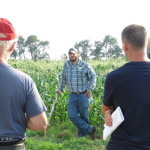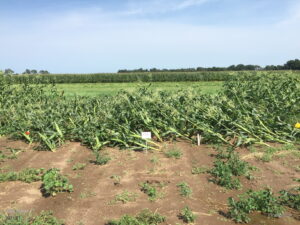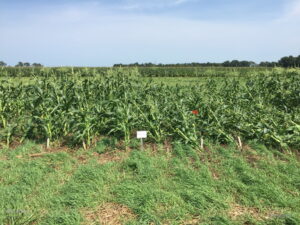
In an article earlier this year we looked at soil under a rye cover crop destined for no-till sweet corn and pumpkin production. At the August 10 Vegetable Field Day at Pinney Purdue, Joe demonstrated how soil in no-till plots where rye had been killed by roller-crimping held together better than soil from the plots which had been tilled in April and kept tilled until planting sweet corn in June.
Overnight after the field day, storms brought heavy rain events (0.2 and 0.4 inch/hour) and strong wind (gusts over 20 and 30 mph with the rain), and by Aug. 11 the drawbacks of full tillage were visible in how much more lodging occurred in tilled plots (Figure 1) than in no-till plots (Figure 2).

Figure 1. Aug. 11. Sweet corn in conventionally tilled plot.

Figure 2. Aug. 11. Sweet corn that was no-till seeded into winter rye roller-crimped before seeding.
There were two varieties of sweet corn in each plot, and the earlier-maturing variety consistently showed more lodging–but for both varieties, lodging appeared worse in the tilled plots. When harvest began the following week, corn had turned upright somewhat, but in the tilled plots there were many ears touching the ground and hand harvest was much slower than usual. The difference in lodging was still visible, as seen in the drone photo in Figure 3. On a vegetable farm this degree of lodging would mean significantly more labor expense for hand harvest, probably make it impossible to machine harvest, and possibly lead to lower value due to dirty husks.

Figure 3. Sweet corn plots a week after wind caused lodging, showing differences in plots where corn was no-tilled into winter rye that had been killed with herbicide in mid-May (left), seeded into soil where winter rye was killed by multiple tillage passes beginning in April (center), or no-tilled into winter rye that was roller-crimped a shortly before corn was planted on June 11.
This story illustrates how soil with good structure can reduce risk on a vegetable farm. It might have been that the no-till plots had improved water infiltration, or deeper rooting, or more strength to support roots against the force of wind. Many practices can improve soil structure; using cover crops and reducing tillage is one option. In our region we expect to see heavy rainfall and wind more frequently in the coming years. Improving soil is one way to prepare for that. The Midwest Cover Crops Council has a wealth of resources on cover crops, and it is not too late to plant something this fall. Find conversations with vegetable farmers about their cover crop use at the HAT Soil Health Podcast.